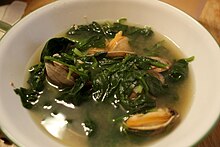|
Clam soup  Clam soup is a soup prepared using clams as a primary ingredient. Clam soup can be prepared as a thin, broth- or cream/milk-based soup and as a thicker, chowder-style soup. In Japan, hot miso soup prepared with clams is believed by some to be a cure for the hangover. OverviewClam soup is prepared using clams as a main ingredient. Additional ingredients can include carrot, celery, onion and other vegetables, vegetable broth or stock or other types of broths and stocks (such as fish stock)[1] seasonings and spices, salt and pepper. Fresh or canned clams can be used to prepare the dish.[2] Clam chowder is a well-known clam soup, but not all clam soups are chowders or have the thick consistency that chowders typically possess. In Japan, hot miso soup with clams is a traditional cure for the hangover.[3] Clams possess high levels of ornithine, an amino acid that some Japanese people believe serves to reduce levels of stress, and "helps improve liver function—including detoxifying harmful substances like alcohol."[3] A canned clam soup product named "Power of 70" claims to cure hangovers.[3] VarietiesClam chowder Clam chowder is a clam soup prepared as a chowder, typically using a cream base.[4] Several varieties of clam chowder exist. Manhattan clam chowder is a tomato-based soup prepared with vegetables and clams, but lacks cream or milk.[4][5][6] Jaecheop-gukJaecheop-guk is a clear Korean soup made with small freshwater clams called jaecheop (재첩, Corbicula leana). It is a local specialty of the Gyeongsang Province where jaecheop are harvested, such as the lower reaches of Nakdong River, and river basins around Gimhae, Myeongji, Eumgung, and Hadan counties[7] as well as places near the Suyeong River in Busan and the Seomjin River.[8] Gallery
See alsoReferences
Further reading
|



